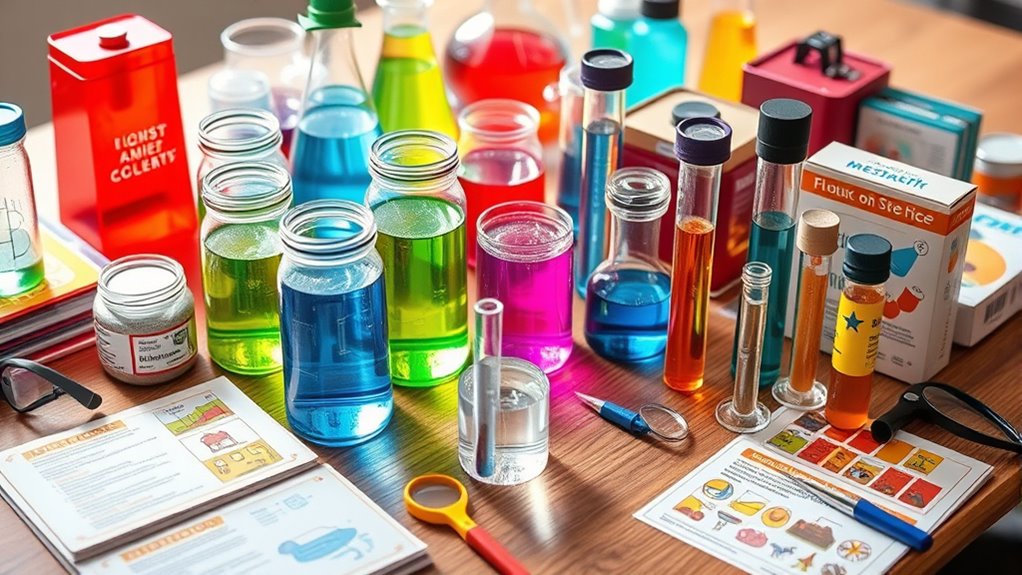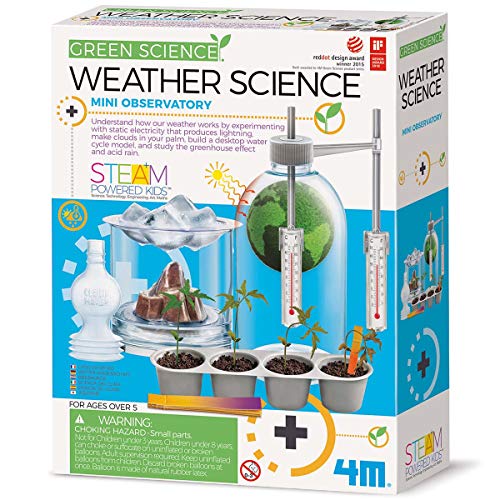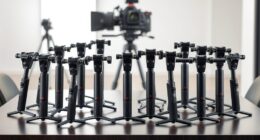If you’re looking for the best science kits to spark a teen’s curiosity, there are great options like water purification sets, extensive experiment collections, chemistry kits, and robotics projects. These kits promote hands-on learning, critical thinking, and STEM skills while being safe and engaging. Whether they’re interested in chemistry, physics, or engineering, choosing the right kit depends on their age and interests. Keep going to find more detailed options that will inspire their passion for science.
Key Takeaways
- Explore kits that combine hands-on experiments in chemistry, physics, and environmental science to engage teenagers’ curiosity.
- Consider advanced robotics and programming kits designed for teens to develop technical skills and problem-solving abilities.
- Look for comprehensive STEM collections offering multiple experiments, fostering critical thinking and sustained interest.
- Prioritize kits with clear instructions, safety features, and opportunities for independent exploration.
- Include options that promote eco-awareness and sustainable science to inspire environmental stewardship among teens.
4M Clean Water Science Lab and STEM Educational Toy
If you’re looking for a science kit that truly engages young learners interested in environmental issues, the 4M Clean Water Science Lab is an excellent choice. It demonstrates how to extract salt from seawater using a simple filter system with materials like sand, rock, activated carbon, and filter paper. Designed for kids 8 and older, it promotes hands-on exploration of water purification, climate change, and ecology. The detailed instructions ensure safe, educational fun. As part of 4M’s diverse STEM collection, it challenges problem-solving skills and sparks curiosity about environmental science, making complex concepts accessible and exciting for young minds passionate about our planet.
Best For: young science enthusiasts aged 8 and older interested in environmental science, water purification, and STEM learning.
Pros:
- Hands-on experiment that demonstrates water purification and salt extraction processes.
- Encourages exploration of important ecological and climate change topics.
- Comes with detailed instructions ensuring safe and educational fun for kids and teens.
Cons:
- May require adult supervision for younger children during setup and use.
- Limited to salt extraction from seawater; may not cover broader water treatment topics.
- Some parts, like filter paper or activated carbon, may need replacement after multiple uses.
UNGLINGA 150 Experiments Science Kits for Kids
The UNGLINGA 150 Experiments Science Kits for Kids is an excellent choice for young learners aged 8 and up who want to plunge into hands-on science. With 150 engaging projects covering earth sciences, chemistry, physics, and surface tension, it offers endless exploration. The kit includes kid-friendly lab tools, safety goggles, and clear, step-by-step instructions, making experiments accessible and fun. Children can perform real scientist-style experiments using household items, fostering curiosity and practical skills. Customers love its educational value, easy-to-follow manuals, and the hours of entertainment it provides. It’s a detailed, quality kit that sparks an early love for STEM.
Best For: young science enthusiasts aged 8 and up seeking an engaging, educational, and hands-on STEM experience at home or school.
Pros:
- Offers 150 diverse experiments covering earth sciences, chemistry, physics, and surface tension, providing extensive learning opportunities.
- Comes with kid-friendly lab tools, safety goggles, and clear step-by-step instructions for easy and safe experimentation.
- Highly rated with an average of 4.7 stars, praised for its fun, educational value, and ability to keep children engaged for hours.
Cons:
- Some users have reported missing items or packaging damage during shipping.
- Instructions are only available in English, which may be a barrier for non-English speakers.
- A few experiments require household items not included in the kit, necessitating additional purchases.
Thames & Kosmos Chemistry Chem C500 Science Kit
Designed for curious teens enthusiastic to explore chemistry hands-on, Thames & Kosmos Chemistry Chem C500 Science Kit offers 28 engaging experiments that make learning both fun and educational. This kit includes a detailed 48-page manual that guides you through experiments like acid-base reactions, gas production, and physical changes, all while explaining the science behind each reaction. It covers foundational concepts such as acids, bases, and states of matter, fostering curiosity and critical thinking. Compact and easy to use, it encourages experimentation and scientific reasoning, making chemistry approachable and exciting for teenagers eager to discover the wonders of science firsthand.
Best For: curious teens and beginner science enthusiasts eager to explore chemistry through hands-on experiments and engaging learning activities.
Pros:
- Includes 28 guided experiments that cover a wide range of chemistry concepts, making learning fun and interactive.
- Comes with a comprehensive 48-page manual that simplifies complex scientific principles for easy understanding.
- Compact and user-friendly design, perfect for at-home experimentation and encouraging scientific reasoning.
Cons:
- May require additional household items or safety equipment not included in the kit.
- Limited to introductory experiments, which might not satisfy advanced or professional chemistry learners.
- The manual’s complexity might be too basic for older or more experienced students seeking in-depth scientific exploration.
Playz Mega Kaboom! Explosive Science Experiments Kit for Kids
is a fantastic science kit designed for kids aged 8-12 who love explosive experiments. It offers over 150 experiments, including balloon rockets, fizzy bombs, and color explosions, guided by an easy-to-follow app and videos. I found it engaging and safe, with clear instructions and fun facts that make learning chemistry and physics exciting. While some users wish it included more chemicals or advanced reactions, overall, it’s a great way to spark curiosity and teach scientific principles. Perfect as a gift or activity, it provides hours of educational fun for young science enthusiasts.
Best For: kids aged 8-12 who are interested in fun, educational explosive science experiments that inspire curiosity and teach basic chemistry and physics concepts.
Pros:
- Offers over 150 engaging experiments with app and video guidance for an interactive learning experience
- Safe and easy to use, making science accessible and enjoyable for young learners
- Encourages curiosity, scientific thinking, and hands-on activity in a fun, educational way
Cons:
- Limited number of chemical reactions and explosions compared to the total experiments listed
- Some users find the kit contains fewer chemicals and advanced materials than expected for a “mega” size
- Instructions may lack depth or contain inaccuracies, requiring supplementary research for better understanding
4M Kidzlabs Anti-Gravity Magnetic Levitation Science Kit
If you’re looking to spark a teen’s curiosity about physics and magnetism, the 4M Kidzlabs Anti-Gravity Magnetic Levitation Science Kit is an excellent choice. It offers engaging hands-on experiments like floating a pencil, levitating screws, and building a maglev device, helping kids understand magnetic forces and levitation technology. The kit includes durable magnets, plastic parts, and clear instructions, making science fun and accessible. While some plastic components may be fragile, users find it effective for fostering curiosity and learning. Overall, it’s a fantastic way to introduce teens to the invisible power of magnetism through creative, interactive experiments.
Best For: parents, teachers, and teens interested in exploring physics and magnetism through engaging, hands-on science experiments.
Pros:
- Promotes understanding of magnetic forces and levitation technology in a fun, interactive way.
- Includes durable magnets and clear instructions suitable for young learners and teens.
- Encourages curiosity, creativity, and critical thinking in STEM education.
Cons:
- Some plastic components may be fragile or require careful handling.
- Parts may not always fit perfectly, potentially affecting the assembly process.
- Small print on instructions can be difficult for younger children to read easily.
ELEGOO UNO R3 Robot Car Kit V4 for Arduino STEM Building Toys
The ELEGOO UNO R3 Robot Car Kit V4 stands out as an excellent choice for teenagers interested in hands-on robotics and programming. Designed for beginners aged 8-16, it offers a thorough STEM experience with 24 modules, including obstacle avoidance, line tracing, and Bluetooth control. Assembly is straightforward, taking about an hour, and the preprogrammed UNO clone allows immediate operation. The kit supports customization, with tools, detailed instructions, and code downloads. Its impressive speed, obstacle navigation, and remote control features make it engaging, while the supportive documentation and solid hardware ensure a rewarding learning journey in electronics and coding.
Best For: beginners aged 8-16 interested in hands-on robotics, programming, and STEM education seeking a versatile and easy-to-assemble robot kit.
Pros:
- Comprehensive set with 24 modules including obstacle avoidance, line tracing, and Bluetooth control for versatile projects
- Detailed instructions, HD tutorials, and downloadable code make setup and learning straightforward
- Solid hardware and quality electronics ensure durability and reliable performance
Cons:
- Assembly can be slightly challenging for complete novices, requiring careful manual interpretation
- Speed may initially be too high, necessitating adjustments for controlled operation
- Some users have experienced software and library compatibility issues needing troubleshooting
Science Kit for Kids with 80 Experiments and Lab Tools
This science kit is perfect for kids aged 6-12 who love hands-on experiments and want to explore science in a fun, engaging way. With 80 experiments and a variety of lab tools like goggles, petri dishes, test tubes, and droppers, it offers endless learning opportunities. Kids can create rainbow rain, erupting volcanoes, and color-changing flowers, making science exciting and interactive. Clear guidance cards help children understand each step and the science behind it. Made from safe, durable materials, the kit is designed for repeated use and indoor exploration. It’s an excellent gift that fosters curiosity, critical thinking, and a love for STEM.
Best For: parents, teachers, and children aged 6-12 who want a safe, educational, and engaging way to explore science through hands-on experiments at home or in the classroom.
Pros:
- Provides 80 diverse experiments that foster curiosity and STEM learning
- Includes high-quality, reusable tools and materials for repeated use
- Clear, step-by-step guidance cards suitable for children to follow independently
Cons:
- Some experiments may require additional household items like water, vinegar, or salt
- Not all necessary supplementary materials are included, which could cause initial setup confusion
- The kit is designed for indoor use, limiting outdoor scientific exploration
STEM Science Kits for Kids with 56 Experiments
For parents and educators seeking an all-inclusive science experience, STEM Science Kits for Kids with 56 experiments stand out as an excellent choice. This kit offers a wide variety of engaging activities, including volcano eruptions, crystal growing, rainbow rain, and colorful fountains, designed for children aged 8-16. Each experiment deepens understanding of scientific concepts while being safe and easy to perform thanks to detailed, colorful instructions. The kit’s high-quality equipment and protective gear ensure safe exploration. Perfect as a gift or educational resource, it inspires curiosity and develops essential scientific skills, making science both fun and accessible for young learners.
Best For: parents, educators, and children aged 8-16 seeking an engaging, educational, and safe way to explore science through hands-on experiments.
Pros:
- Offers 56 varied experiments that cover a wide range of scientific concepts and skills.
- Includes high-quality equipment and protective gear for safe, confident exploration.
- Comes with a clear, colorful manual that makes complex experiments accessible and fun.
Cons:
- May require adult supervision for younger children to ensure safety during certain experiments.
- The extensive variety might be overwhelming for some children to complete all experiments in a short period.
- The kit’s size and contents may be less suitable for very young children under age 8.
Robot Building Kit for Kids Ages 8-16 with APP or Remote Control STEM Educational Gift
With over 468 pieces, the Robot Building Kit offers an engaging STEM experience that’s perfect for kids aged 8 to 16 who love hands-on learning. It includes stickers, a step-by-step manual, and versatile components that promote creativity, problem-solving, and practical skills. The robot can move in all directions, with glowing eyes, rotating joints, and transforming features that captivate kids’ curiosity. Controlled via a phone app or remote, it offers modes like voice, path, gravity sensor, and programming, making play flexible and educational. Made from durable, non-toxic materials, it’s a safe, high-quality gift that sparks imagination and STEM exploration.
Best For: kids aged 8-16 who enjoy hands-on STEM activities, building projects, and interactive robotics play.
Pros:
- Offers extensive 468+ building pieces that promote creativity and problem-solving skills.
- Features multiple control modes including app, remote, voice, and sensor for versatile play.
- Made from durable, non-toxic materials ensuring safety and high-quality construction.
Cons:
- Assembly may be challenging for younger children without adult supervision.
- Requires compatible devices (smartphone or remote) for full functionality.
- The complexity of features might be overwhelming for very young or beginner builders.
Playz Edible Candy Making Science Kit for Kids
If you’re looking for a fun and educational science kit that sparks creativity and introduces kids to food chemistry, the Playz Edible Candy Making Science Kit for Kids is an excellent choice. It offers over 40 experiments, including making chocolates, jelly candies, rock candy, and lollipops, providing a real lab experience with 21 tools and ingredients. The colorful 32-page guide makes complex concepts accessible, encouraging STEM learning through hands-on activities. Kids will love experimenting with flavors and textures, developing scientific thinking, creativity, and practical skills. It’s perfect for curious young food scientists, especially with adult supervision for best results.
Best For: parents, teachers, and curious kids aged 8-12 who want a fun, educational, and hands-on introduction to food science and chemistry through edible candy-making experiments.
Pros:
- Offers 40+ engaging experiments that teach STEM concepts through edible activities.
- Includes a comprehensive 32-page colorful guide making complex ideas accessible to children.
- Encourages creativity, scientific thinking, and practical skills in a fun, interactive way.
Cons:
- Many recipes require additional household ingredients not included in the kit.
- Some candies may have textures or flavors that differ from store-bought treats.
- Preparation and cleanup can be time-consuming and require adult supervision and involvement.
Playz Coding & Computer Science Kit for Kids and Teens
The Playz Coding & Computer Science Kit stands out as an ideal choice for young learners enthusiastic to grasp core tech concepts without needing a computer. I love how it makes complex topics like binary codes, encryption, and algorithms accessible through hands-on activities. Kids can create binary necklaces, ancient encryption devices, and pixel art, making learning both fun and interactive. With over 30 tools and a colorful instruction guide, it’s easy for children to follow along independently. This kit promotes critical thinking and STEM skills in a simple, engaging way, inspiring curiosity about technology while ensuring a rewarding learning experience at home or in the classroom.
Best For: young children and teens aged 6-12+ who want to learn foundational computer science concepts through hands-on, screen-free activities.
Pros:
- Engages kids with fun, interactive projects like creating binary necklaces and pixel art.
- Includes over 30 tools and a colorful, easy-to-follow instruction guide suitable for independent learning.
- Promotes STEM skills, critical thinking, and understanding of complex topics in a simple, accessible way.
Cons:
- May require adult supervision for younger children to ensure proper use of tools.
- Limited to physical activities, so it does not provide actual computer programming experience.
- Some users might find the instruction guide less detailed for advanced learners seeking deeper knowledge.
NATIONAL GEOGRAPHIC Science Magic Kit for Kids
The NATIONAL GEOGRAPHIC Science Magic Kit for Kids stands out as an excellent choice for stimulating curiosity and hands-on learning in children aged 8 and above. It includes over 100 experiments and magic tricks that blend science with entertainment, like bending metal with water or making test tubes vanish. The kit offers clear instructions for 20 magic tricks and 85+ bonus experiments using common household items, encouraging extended engagement. Kids develop critical thinking while exploring physics and chemistry concepts. Parents praise its safety, organization, and educational value, making it an inspiring tool to foster creativity and a lifelong love of science.
Best For: children aged 8 and above who are interested in hands-on science experiments, magic tricks, and fostering curiosity about STEM concepts.
Pros:
- Over 100 engaging experiments and magic tricks that combine education and entertainment
- Clear, easy-to-follow instructions suitable for independent or family use
- Promotes critical thinking, creativity, and a love for science in a safe, organized package
Cons:
- Some powders may need to be discarded after opening, leading to waste
- Resealable packaging could improve convenience for repeated use
- The price, while reasonable, might be considered high for some budgets given the scope of activities
National Geographic Magic Chemistry Set for Kids
Discover the National Geographic Magic Chemistry Set for Kids, a perfect choice for young science enthusiasts enthusiastic to explore chemistry through fun, hands-on experiments. This kit features 10 engaging science tricks, like making coins float, changing water colors, and creating snow, designed to amaze and teach scientific principles. It includes a magic wand and gloves, adding excitement and encouraging kids to perform for others. The clear, illustrated instructions make experiments easy to follow, while providing insights into the science behind each trick. All necessary tools are included, so kids can start their magical chemistry adventures immediately. It’s a fun, educational way to spark curiosity and foster a love for science.
Best For: young children and aspiring young scientists who want a fun, interactive way to learn chemistry through magical experiments.
Pros:
- Engages kids with 10 exciting science tricks that combine fun and education
- Includes all necessary tools and easy-to-follow instructions for hassle-free setup
- Developed by Blue Marble, a reputable brand recognized for quality and educational value
Cons:
- May require adult supervision for younger children during experiments
- Limited to 10 pre-designed experiments, which might encourage seeking more variety
- The magic-themed presentation might appeal more to younger kids than older science enthusiasts
National Geographic Gross Science Kit with 45 Experiments
If you’re looking for a science kit that captures kids’ curiosity with its gross and engaging experiments, the National Geographic Gross Science Kit is an excellent choice. It offers 45 hands-on activities, including dissecting a brain, making slime, and creating glowing worms. Designed for kids aged 8-12, it combines fun with learning about polymers, chemical reactions, and pH science. The kit includes all necessary materials, organized in a sturdy box, with clear, kid-friendly instructions. Many reviews praise its educational value and entertainment factor, making it perfect for curious, gross-loving children who want to explore science in a messy, exciting way.
Best For: curious children aged 8-12 who love gross, engaging, and hands-on science experiments that combine learning with fun.
Pros:
- Offers 45 diverse gross science activities that keep kids entertained for hours
- Includes all necessary materials organized in a durable, kid-friendly setup
- Promotes STEM learning through engaging experiments like dissecting a brain and making slime
Cons:
- Some experiments can be messy and may require adult supervision and preparation
- The kit may be too gross for very sensitive children or those with certain health concerns
- Requires space and proper cleanup after use, which might be inconvenient for some families
Toysmith Green Weather Science Kit for Kids
Looking for a science kit that combines fun with environmental awareness? The Toysmith Green Weather Science Kit for Kids is perfect. It introduces kids to green concepts like recycling, climate change, and weather phenomena through six hands-on experiments. I love how it uses household ingredients for activities like cloud formation, static electricity, and wind observation, making learning both accessible and engaging. The kit is easy to assemble, offers detailed instructions, and can be enjoyed by children aged 8 and up. With a high rating and educational focus, it’s a great way to inspire curiosity about our environment while having fun exploring weather and green science principles.
Best For: children aged 8 and up who are interested in exploring weather, environmental issues, and green science concepts through hands-on experiments.
Pros:
- Engages children with fun, educational activities that promote STEM learning and environmental awareness
- Easy to assemble with clear instructions, suitable for family and classroom use
- Uses household ingredients for experiments, making it accessible and cost-effective
Cons:
- Small parts may require adult supervision, especially for younger children under 11
- Assembly can be complex for some users, needing modifications like sanding bottle caps for better fit
- Limited to a specific set of experiments, which may require additional materials for extended activities
Factors to Consider When Choosing Science Kits for Teenagers

When selecting a science kit for a teenager, I always think about whether the content matches their age and skill level. Safety and quality of materials are also key, so I look for kits with reliable components and clear instructions. Finally, I consider the educational value and how well the kit fits within my budget to make certain it’s both engaging and worthwhile.
Age-Appropriate Content
Choosing the right science kit for a teenager depends heavily on ensuring the content matches their age and skill level. I recommend selecting kits designed for ages 12 and up, so the experiments are challenging but not overwhelming. Check that the complexity aligns with their prior knowledge to keep them engaged without frustration. Look for kits that cover advanced topics like robotics, chemistry, or electronics to spark curiosity and provide meaningful learning. Safety features are essential, especially for experiments involving chemicals or electrical components—make sure supervision requirements are appropriate. Finally, choose kits that encourage independent exploration and critical thinking, fostering curiosity while allowing teens to learn confidently on their own. An age-appropriate kit truly sets the stage for a rewarding science adventure.
Skill Level Complexity
Finding the right level of complexity in a science kit helps guarantee that teens stay engaged and challenged without feeling overwhelmed. I recommend choosing kits that match their current knowledge to prevent frustration or boredom. Some kits are designed with basic experiments perfect for beginners, while others offer advanced projects for more experienced learners. It’s also important to check if the kit provides detailed instructions and explanations to help deepen understanding of complex concepts. I look for kits that allow for progressive learning, enabling teens to build skills gradually through increasingly challenging activities. Equally, the difficulty should align with their interest and problem-solving abilities, fostering confidence and independent exploration. Finding that balance keeps curiosity alive and promotes meaningful scientific growth.
Safety and Materials
Ensuring safety and selecting appropriate materials are crucial steps when choosing science kits for teenagers. I always check that the kit is made from non-toxic, child-safe materials that meet safety standards like ASTM or EN71. Clear labels with safety warnings and handling instructions are essential to prevent mishaps. It’s also important that the kit includes safety gear such as goggles and gloves to protect young experimenters. I look for durable, well-constructed components that can withstand repeated use without breaking or causing hazards. Additionally, verifying the age recommendations helps ensure the kit’s complexity and safety features match a teenager’s maturity and skill level. Prioritizing these factors ensures a safe, engaging, and educational experience during their scientific exploration.
Educational Focus
When selecting a science kit for teenagers, it’s important to contemplate how well it aligns with their educational interests, such as chemistry, physics, biology, or environmental science. This guarantees they stay engaged and motivated. The kit should include clear, easy-to-understand instructions that promote independent learning and reinforce core scientific concepts. Activities should challenge their critical thinking and problem-solving skills, encouraging deeper exploration. High-quality, durable materials are essential for safety, repeated use, and a positive hands-on experience. Additionally, the kit should support curriculum standards or STEM learning goals, offering relevant, age-appropriate content that complements their formal education. This focus helps teens develop a stronger understanding of scientific principles while fostering curiosity and confidence in their abilities.
Budget and Value
Choosing the right science kit for teenagers means balancing cost with educational value. I recommend comparing the number and complexity of experiments to guarantee they match the teen’s skill level and interests, which helps maximize perceived value. Look for kits that include high-quality materials and tools, as this justifies the investment and ensures durability and safety during use. It’s also beneficial to find kits with extensive instructions or digital resources that enhance learning without needing extra purchases, offering better long-term value. Consider whether the kit provides multiple experiments or expandable components that keep teens engaged over time. Ultimately, finding a balance between affordability and the potential for ongoing exploration assures the kit remains both a worthwhile and inspiring investment in their curiosity.
Frequently Asked Questions
What Safety Precautions Are Recommended for Teenage Science Kits?
When using teen science kits, I always recommend wearing safety goggles and gloves to protect your eyes and skin. Make sure to work in a well-ventilated area and follow the instructions carefully. Keep chemicals out of reach of younger kids, and never mix substances without knowing the risks. Supervision is essential if you’re unsure about any step, ensuring safety while you explore and learn.
How Do Science Kits Promote Long-Term Interest in STEM Fields?
Think of science kits as seeds planted in a young mind’s garden. They spark curiosity and nurture critical thinking, blossoming into a passion for STEM. When teens explore hands-on experiments, they connect abstract concepts to real-world applications, fueling long-term interest. These kits also build confidence, encouraging continuous exploration. Over time, that initial spark grows into a lifelong pursuit, turning curiosity into a future career in science, technology, engineering, or math.
Are There Science Kits Suitable for Teenagers With Limited Prior Experience?
There are science kits designed for teenagers with limited experience that are user-friendly and engaging. I recommend starting with kits that include clear instructions and basic experiments, like beginner chemistry or simple robotics sets. These kits build confidence and curiosity without overwhelming. They’re perfect for sparking interest and gradually introducing more complex concepts, making science both accessible and fun for newcomers.
Can Science Kits Be Customized for Different Skill Levels?
Absolutely, science kits can be tailored to different skill levels, making each project feel like a personalized adventure. I’ve seen kits with adjustable complexity, allowing teens to progress at their own pace while still feeling challenged and engaged. It’s like customizing a recipe—adding more ingredients for flavor or keeping it simple for a quick treat. This flexibility helps nurture curiosity and confidence, making science both accessible and exciting.
What Age Range Is Ideal for Most Science Kits for Teenagers?
Most science kits for teenagers are ideal for ages 12 to 16. I recommend starting with kits designed for early teens, as they usually balance complexity and fun, keeping kids engaged without feeling overwhelmed. Younger teens might enjoy beginner kits, while older ones can handle more advanced experiments. Picking the right age-appropriate kit helps spark curiosity and guarantees they get the most out of their scientific exploration.
Conclusion
Choosing the right science kit can truly light a fire of curiosity in teenagers. With so many exciting options out there, it’s important to pick one that sparks their interest and encourages hands-on learning. Remember, the right kit can be a game-changer, opening up a world of discovery. So don’t just scratch the surface—dive in and let their scientific journey take flight! After all, the sky’s the limit when curiosity is your guide.

























